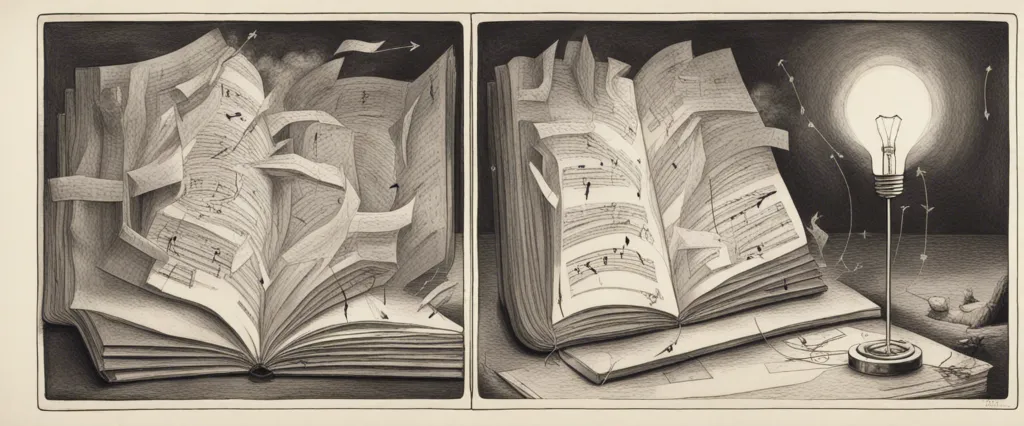
In the vast realm of literature, there exist countless guides and handbooks that offer insight into the craft of writing. Among these, two renowned works, Plot And Structure by James Scott Bell and “On Writing Well” by William Zinsser, stand tall as pillars of wisdom for aspiring writers. Both books, although differing in their focal points, share the common goal of equipping writers with the necessary tools to master their craft. While “Plot and Structure” delves deep into the art of constructing compelling plots, “On Writing Well” imparts invaluable guidance on the art of clear and concise writing. This comparative study will explore how these two literary behemoths approach the craft of writing, highlighting their unique perspectives and examining the ways in which they complement and diverge from one another. By analyzing the strengths and weaknesses of each work, we will unravel the tapestry of their teachings, ultimately aiming to glean a comprehensive understanding of the art of writing through the dual lenses of “Plot and Structure” and “On Writing Well.
Brief Summary of Two Books
Plot And Structure by James Scott Bell
Plot and Structure” by James Scott Bell is a comprehensive guide for writers that focuses on creating compelling plots and well-structured stories. The book explores various elements of plot development and offers practical tips to help writers build engaging narratives.
Bell begins by emphasizing the importance of a strong plot and its role in capturing readers’ attention. He breaks down the concept of plot into different components, such as the setup, conflict, complications, climax, and resolution. By dissecting these elements, he provides writers with a clear understanding of how to create a solid foundation for their stories.
The book delves into the concept of structure and how it impacts the overall flow of a story. Bell explores different structural models like the three-act structure and the hero’s journey, guiding writers on how to utilize them effectively to enhance their narratives. He also explains the significance of pacing, dialogue, and character development in maintaining a strong storyline.
Bell offers practical advice on crafting engaging openings and satisfying endings that leave a lasting impact on readers. He provides valuable tips on creating tension, suspense, and conflict, urging writers to keep readers hooked from start to finish. Additionally, he emphasizes the importance of character arcs and how they contribute to the overall plot progression.
Throughout the book, Bell provides examples from well-known novels and movies to illustrate his points, and he incorporates various writing exercises to help writers practice and apply the concepts discussed.
Overall, “Plot and Structure” serves as a valuable resource for writers seeking to improve their storytelling abilities. By focusing on the fundamental elements of plot and structure, James Scott Bell provides a practical and informative guide filled with actionable advice for aspiring authors.
On Writing Well by William Zinsser
On Writing Well” by William Zinsser is a comprehensive guide that teaches readers how to effectively write nonfiction. Zinsser emphasizes the importance of simplicity and clarity in writing, encouraging writers to eliminate unnecessary words, phrases, and jargon. He explains the art of storytelling and the importance of voice in creating engaging and relatable narratives. Zinsser provides insightful tips on various aspects of writing, such as organizing thoughts, conducting interviews, and using humor. The book also covers common writing challenges, including writing about science, sports, and business. Overall, “On Writing Well” is a valuable resource that equips writers with the essential tools to communicate effectively and connect with readers.
Comparison between Two Books

Similarities in Writing
In both “Plot & Structure” by James Scott Bell and “On Writing Well” by William Zinsser, there are several similarities in their approach to writing. Despite focusing on different aspects of writing (plot and structure vs. writing style and technique), the books share some common ground:
1. Clear and concise writing: Both Bell and Zinsser emphasize the importance of clarity in writing. They encourage writers to use simple and direct language to convey their ideas effectively. Bell advises eliminating unnecessary words and focusing on writing with precision, while Zinsser stresses the importance of simplicity and cutting out clutter.
2. Audience-oriented writing: Both authors highlight the significance of considering the reader while writing. They stress the need for writers to be aware of their target audience and tailor their writing style accordingly. Bell discusses the importance of knowing what readers want and delivering it to them, whereas Zinsser encourages writers to think about their readers’ needs and ensure their writing addresses those needs.
3. Craftsmanship and practice: Both books acknowledge that writing is a craft that requires diligent practice and constant improvement. Bell emphasizes the need for writers to hone their skills by writing regularly and studying the craft, while Zinsser encourages writers to refine their work through multiple drafts and revisions.
4. Structure and organization: Bell’s book specifically focuses on the plotting and structural elements of a story, while Zinsser explores the organization and structure of non-fiction writing. Both authors stress the importance of having a clear and logical structure in writing. Bell offers various plot structures and techniques, while Zinsser provides guidance on organizing thoughts and ideas effectively.
5. Personal anecdotes and examples: Both Bell and Zinsser use personal anecdotes and examples to illustrate their points and make the concepts more relatable to readers. They provide real-life examples from their own experiences as writers or from notable authors, offering practical tips and insights.
In summary, while “Plot & Structure” and “On Writing Well” differ in their specific areas of focus, they share common ground in their emphasis on clear writing, audience awareness, craftsmanship, structure, and the use of personal anecdotes and examples. Both books provide valuable guidance and techniques to assist aspiring writers in improving their writing skills.
Divergences in Writing
“Plot and Structure” by James Scott Bell and “On Writing Well” by William Zinsser are both popular books in the writing craft genre that provide valuable insights and techniques for aspiring writers. While they tackle different aspects of writing, there are notable divergences between the two books when it comes to the topic of writing itself.
In “Plot and Structure,” Bell primarily focuses on the storytelling elements of fiction, with an emphasis on constructing a compelling plotline that engages readers. He offers various techniques for developing characters, creating conflict, building tension, and crafting satisfying resolutions. Bell’s book delves deep into the mechanics of plotting, offering step-by-step guidance and practical exercises to help writers strengthen their storytelling abilities. He provides specific examples and analyses of successful novels to illustrate his points effectively.
On the other hand, Zinsser’s “On Writing Well” takes a broader perspective on writing, appealing to both nonfiction and fiction writers. In this book, Zinsser focuses on the craft of writing itself, emphasizing the importance of clarity and simplicity. He advises writers to trim excess words, avoid jargon, and strive for concise, lucid prose. Zinsser’s approach is rooted in the belief that good writing transcends genres, and that the principles he outlines can be applied to any form of writing, be it journalism, memoirs, or technical writing. He encourages writers to find their unique voice and cultivates a sense of confidence in their abilities.
The divergence between the two books lies in their primary focus. While “Plot and Structure” concentrates heavily on the elements of storytelling and constructing engaging plots, “On Writing Well” takes a more holistic approach by focusing on writing as a skill applicable to various genres. Bell’s book caters specifically to fiction writers, addressing their specific needs and challenges, while Zinsser’s book appeals to a wider range of writers seeking to improve their overall writing skills.
Furthermore, the two books diverge in terms of their style and tone. Bell adopts a more instructional tone, using a formulaic approach to guide aspiring writers through the plot creation process. His book is filled with specific techniques and guidelines, providing a structured framework for writers to follow. On the other hand, Zinsser’s writing style is more conversational and anecdotal. He shares stories from his own experiences as a writer and offers advice with a warm and encouraging tone, emphasizing the importance of finding one’s own voice and honing the craft of writing.
In conclusion, while “Plot and Structure” by James Scott Bell and “On Writing Well” by William Zinsser both offer valuable insights into the craft of writing, they approach the topic from different angles. Bell’s book is tailored towards fiction writers, delving deep into plot construction and storytelling elements, while Zinsser’s book takes a more holistic approach, focusing on the art of writing itself and its application to various genres. The divergence between the two books lies in their primary focus, style, and tone, making them complementary resources for aspiring writers with different needs and interests.

Conclusion
Both “Plot and Structure” by James Scott Bell and “On Writing Well” by William Zinsser are highly regarded books in the writing community. The choice between them ultimately depends on your specific writing goals and interests.
If you are primarily interested in improving your fiction writing skills, then “Plot and Structure” by James Scott Bell would be the more fitting choice. This book delves into the intricacies of plot development, character arcs, and crafting compelling stories. Bell provides practical advice and exercises to help writers understand and master these important elements of storytelling. It is particularly helpful for aspiring fiction authors or those looking to deepen their understanding of plot construction.
On the other hand, if you are more interested in improving your overall writing style, clarity, and communication skills, then “On Writing Well” by William Zinsser would be a better fit. This book focuses on non-fiction writing, covering various genres such as journalism, memoirs, and business writing. Zinsser shares his insights on writing with simplicity, precision, and effectiveness, offering practical tips to help writers of all levels enhance their prose.
In summary, if you are primarily focused on improving fiction writing, “Plot and Structure” by James Scott Bell would be more suitable. If you want to improve your overall writing skills and style, “On Writing Well” by William Zinsser is the recommended choice.



